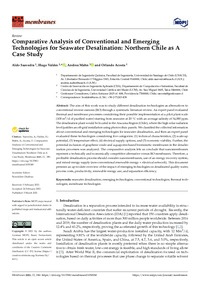Mostrar el registro sencillo de la publicación
Comparative analysis of conventional and emerging technologies for seawater desalination: Northern Chile as a case study
| dc.contributor.author | Saavedra, Aldo | |
| dc.contributor.author | Valdés-Riquelme, Hugo | |
| dc.contributor.author | Mahn, Andrea | |
| dc.contributor.author | Acosta, Orlando | |
| dc.date.accessioned | 2021-12-28T14:01:32Z | |
| dc.date.available | 2021-12-28T14:01:32Z | |
| dc.date.issued | 2021 | |
| dc.identifier.uri | http://repositorio.ucm.cl/handle/ucm/3668 | |
| dc.description.abstract | The aim of this work was to study different desalination technologies as alternatives to conventional reverse osmosis (RO) through a systematic literature review. An expert panel evaluated thermal and membrane processes considering their possible implementation at a pilot plant scale (100 m3/d of purified water) starting from seawater at 20 °C with an average salinity of 34,000 ppm. The desalination plant would be located in the Atacama Region (Chile), where the high solar radiation level justifies an off-grid installation using photovoltaic panels. We classified the collected information about conventional and emerging technologies for seawater desalination, and then an expert panel evaluated these technologies considering five categories: (1) technical characteristics, (2) scale-up potential, (3) temperature effect, (4) electrical supply options, and (5) economic viability. Further, the potential inclusion of graphene oxide and aquaporin-based biomimetic membranes in the desalinization processes was analyzed. The comparative analysis lets us conclude that nanomembranes represent a technically and economically competitive alternative versus RO membranes. Therefore, a profitable desalination process should consider nanomembranes, use of an energy recovery system, and mixed energy supply (non-conventional renewable energy + electrical network). This document presents an up-to-date overview of the impact of emerging technologies on desalinated quality water, process costs, productivity, renewable energy use, and separation efficiency. | es_CL |
| dc.language.iso | en | es_CL |
| dc.rights | Atribución-NoComercial-SinDerivadas 3.0 Chile | * |
| dc.rights.uri | http://creativecommons.org/licenses/by-nc-nd/3.0/cl/ | * |
| dc.source | Membranes, 11(3), 180 | es_CL |
| dc.subject | Seawater desalination | es_CL |
| dc.subject | Emerging technologies | es_CL |
| dc.subject | Conventional technologies | es_CL |
| dc.subject | Thermal technologies | es_CL |
| dc.subject | Membrane technologies | es_CL |
| dc.title | Comparative analysis of conventional and emerging technologies for seawater desalination: Northern Chile as a case study | es_CL |
| dc.type | Article | es_CL |
| dc.ucm.facultad | Facultad de Ciencias de la Ingeniería | es_CL |
| dc.ucm.indexacion | Scopus | es_CL |
| dc.ucm.indexacion | Isi | es_CL |
| dc.ucm.uri | www.mdpi.com/2077-0375/11/3/180 | es_CL |
| dc.ucm.doi | doi.org/10.3390/membranes11030180 | es_CL |




